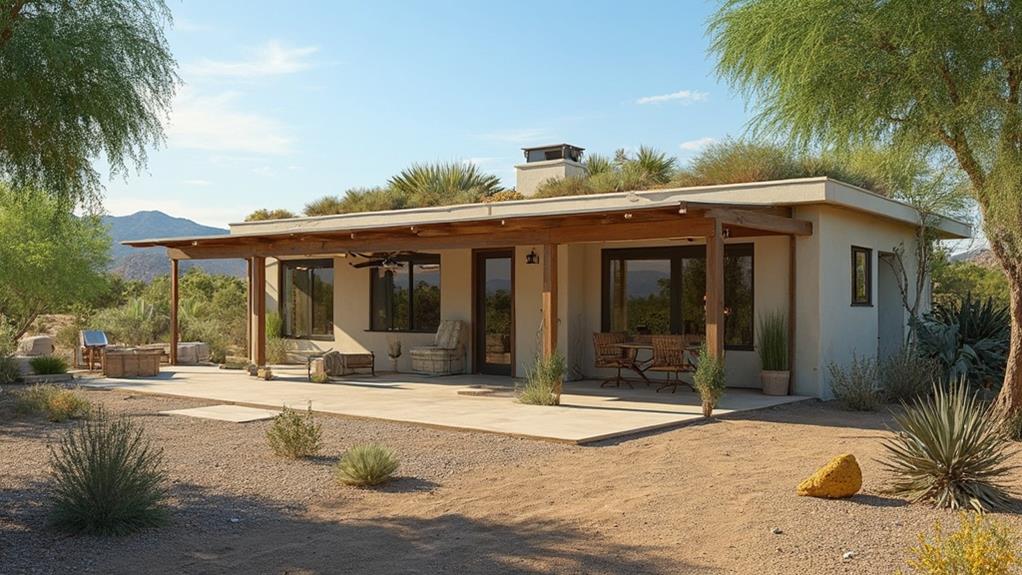Renovating with shade offers powerful, eco-friendly solutions for cooling homes in hot climates. Strategic landscaping with trees and vegetation acts as nature's air conditioner, while exterior shading devices like awnings and overhangs block intense sunlight. Cool roofing technologies reflect heat, reducing energy costs and urban heat island effects. Efficient window treatments and glazing minimize heat gain, while reflective paints and coatings lower surface temperatures. These methods work together to create a comfortable indoor environment without relying heavily on air conditioning. By incorporating these shade-based cooling strategies, homeowners can significantly improve their living spaces and reduce energy consumption. Exploring these techniques further reveals additional benefits and implementation strategies.
Strategic Landscaping for Natural Cooling
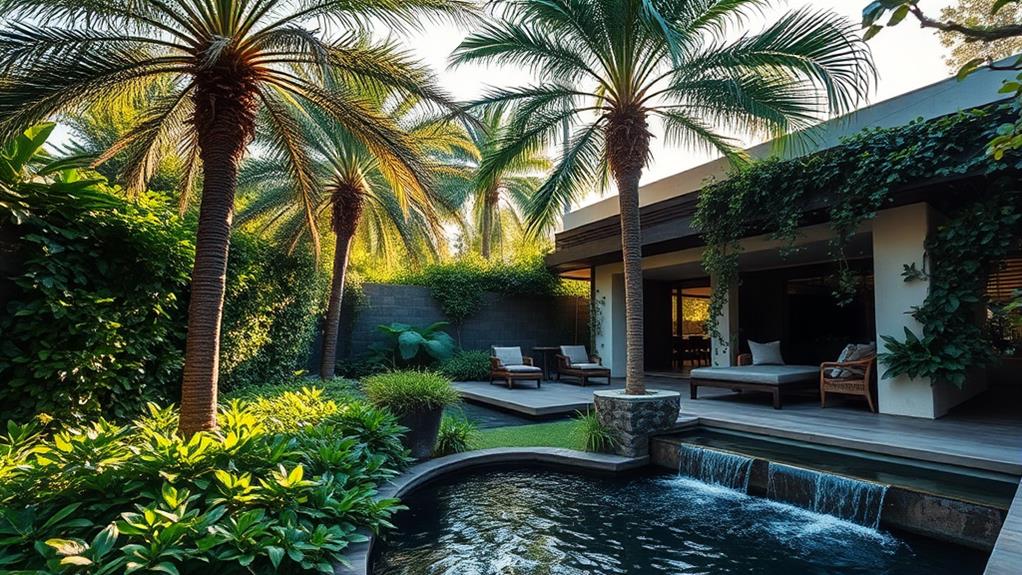
Trees and vegetation serve as nature's air conditioners, offering an effective and eco-friendly approach to cooling in hot climates. Strategic landscaping can significantly reduce indoor temperatures and energy costs by providing shade and evaporative cooling.
Deciduous trees planted on the south and west sides of a building block intense summer sun while allowing beneficial winter sunlight to penetrate. Large shade trees can lower surrounding air temperatures by up to 6°C (11°F).
Shrubs and vines strategically placed near windows and walls act as insulators, reducing heat gain and creating cooler microclimates. Green roofs and vertical gardens not only provide insulation but also absorb solar radiation, further decreasing cooling needs. Proper placement of plants can channel cooling breezes towards the building while blocking hot, dry winds.
Water features like ponds or fountains enhance the cooling effect through evaporation. Replacing heat-absorbing surfaces like asphalt with permeable materials or groundcover reduces the urban heat island effect. By carefully selecting and positioning vegetation, homeowners can create a natural cooling system that complements architectural design and reduces reliance on artificial cooling methods.
Exterior Shading Devices
Numerous exterior shading devices offer effective solutions for reducing heat gain in hot climates. These devices intercept solar radiation before it reaches the building envelope, significantly lowering cooling costs and enhancing indoor comfort.
Retractable awnings provide flexible shading for windows and outdoor spaces, allowing adjustment based on sun position and seasonal changes. Fixed overhangs, when properly designed, can block high summer sun while admitting lower winter sun for passive heating. Exterior roller shades and screens offer a sleek, modern appearance while effectively reducing solar heat gain and glare.
Vertical fins or louvers are particularly useful for east and west-facing facades, intercepting low-angle sunlight. Pergolas and trellises, combined with deciduous vines, create natural, dynamic shading that adapts to seasonal variations. For larger buildings, solar shading systems like brise-soleil can be integrated into the architectural design, enhancing both aesthetics and functionality.
When selecting exterior shading devices, consider factors such as local climate, building orientation, window sizes, and architectural style. Proper installation and maintenance are crucial for ensuring long-term performance and durability in hot climates.
Cool Roofing Technologies
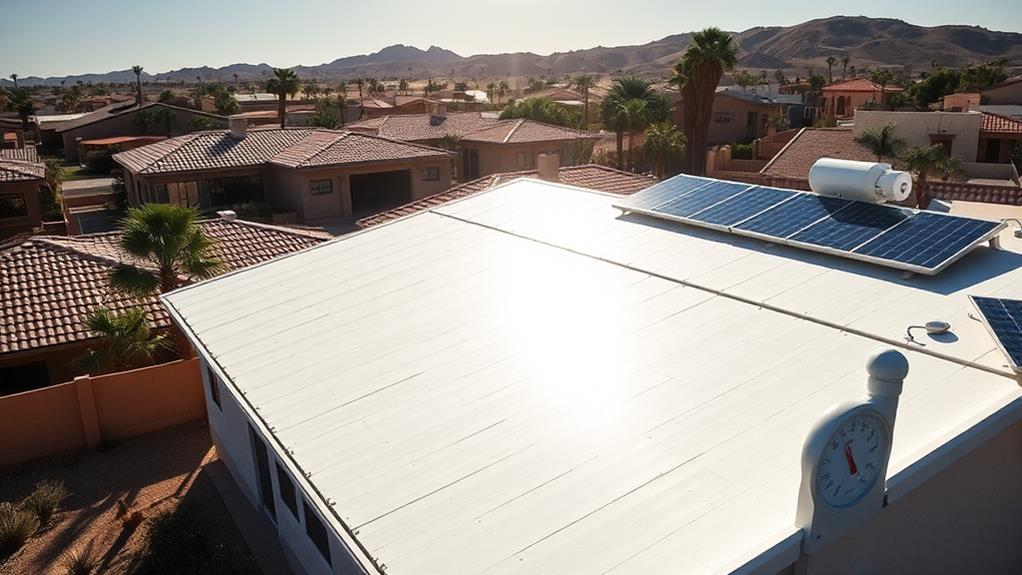
Among the most effective strategies for mitigating heat gain in hot climates, cool roofing technologies stand out as a paramount solution. These innovative materials and designs reflect more sunlight and absorb less heat than traditional roofing, significantly reducing the thermal load on buildings.
Cool roofs typically employ high-albedo surfaces, which reflect a greater percentage of solar radiation. This can be achieved through various means, including reflective coatings, light-colored tiles, or specially engineered membranes. Some advanced cool roofing systems incorporate phase-change materials that absorb heat during the day and release it at night, further enhancing their cooling capabilities.
The benefits of cool roofing extend beyond individual buildings. On a larger scale, widespread adoption can help mitigate the urban heat island effect, lowering ambient temperatures in densely populated areas. Additionally, cool roofs can contribute to energy savings by reducing the need for air conditioning, thereby decreasing both electricity costs and carbon emissions. When considering renovation options for hot climates, cool roofing technologies offer a compelling combination of immediate comfort improvements and long-term sustainability benefits.
Window Treatments and Glazing
While cool roofing technologies address heat gain from above, effective window treatments and glazing solutions tackle solar radiation entering through the building's openings. These strategies play a crucial role in maintaining comfortable indoor temperatures and reducing energy consumption in hot climates.
Window treatments like reflective blinds, thermal curtains, and exterior shades can significantly reduce heat gain. Reflective blinds bounce sunlight back outside, while thermal curtains provide insulation. Exterior shades, such as awnings or solar screens, block sunlight before it reaches the glass, offering superior heat reduction.
Glazing technologies have advanced considerably, offering various options for heat management. Low-emissivity (low-E) glass coatings reflect infrared light, reducing heat transfer while allowing visible light to pass through. Double or triple-pane windows with inert gas fills between panes provide excellent insulation. Spectrally selective glazing filters out heat-generating infrared light while admitting visible light, balancing natural illumination and heat reduction.
Smart glass technologies, like electrochromic or thermochromic glass, can dynamically adjust their tint or opacity in response to sunlight or electrical current, offering adaptable solar control throughout the day.
Reflective Paints and Coatings
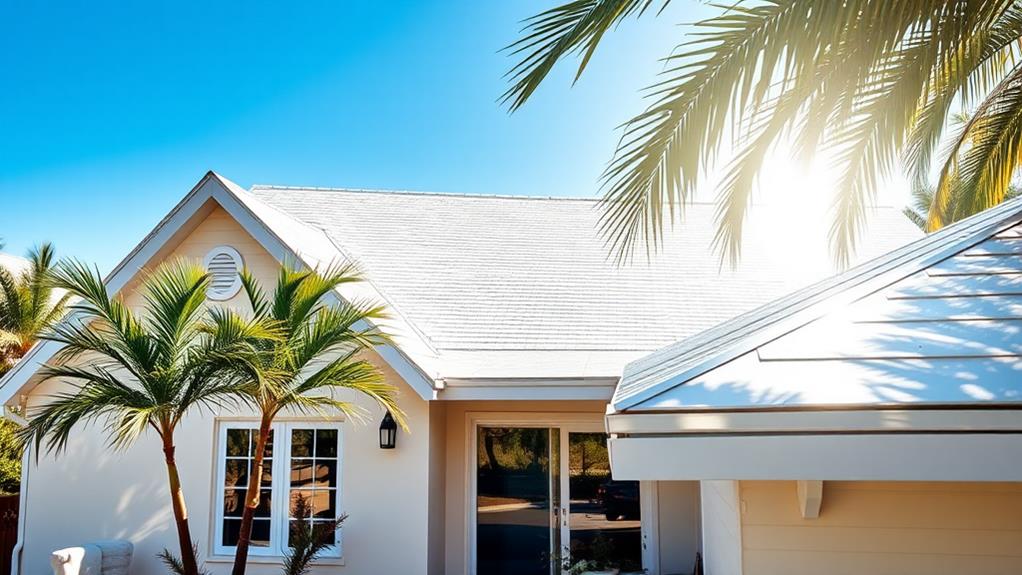
Reflective paints and coatings represent a cost-effective and easily implementable solution for reducing heat absorption in buildings located in hot climates. These specialized products are designed to reflect a significant portion of solar radiation, preventing it from being absorbed by the building's exterior surfaces. By reflecting sunlight and heat away from the structure, these coatings can substantially lower interior temperatures and reduce cooling costs.
The effectiveness of reflective paints and coatings is measured by their solar reflectance index (SRI), which indicates the material's ability to reject solar heat. High-performance coatings can reflect up to 85% of solar radiation, making them particularly beneficial for roofs and walls exposed to direct sunlight. These products are available in various formulations, including ceramic-based coatings, elastomeric paints, and cool roof coatings.
When applied to roofs, they can lower surface temperatures by up to 50°F (28°C) compared to traditional dark-colored roofing materials. This temperature reduction not only improves indoor comfort but also extends the lifespan of roofing materials by minimizing thermal stress and UV damage.
Passive Cooling Architectural Design
Passive cooling architectural design encompasses a range of strategies that harness natural elements and building physics to maintain comfortable indoor temperatures without relying on mechanical cooling systems. These techniques focus on minimizing heat gain and maximizing heat dissipation through careful building orientation, layout, and material selection.
Key elements of passive cooling design include strategic shading, natural ventilation, and thermal mass. Shading devices such as overhangs, louvers, and pergolas block direct sunlight, reducing solar heat gain. Proper building orientation and window placement facilitate cross-ventilation, allowing cool air to flow through the structure and hot air to escape. Thermal mass, achieved through materials like concrete or stone, absorbs heat during the day and releases it at night, moderating temperature fluctuations.
Other passive cooling strategies include green roofs, which provide insulation and evaporative cooling, and courtyards or atriums that create microclimates and enhance air circulation. Underground or earth-sheltered construction takes advantage of the earth's stable temperatures. By integrating these passive design principles, architects can significantly reduce energy consumption and create more sustainable, comfortable living spaces in hot climates.
Thermal Mass for Temperature Regulation
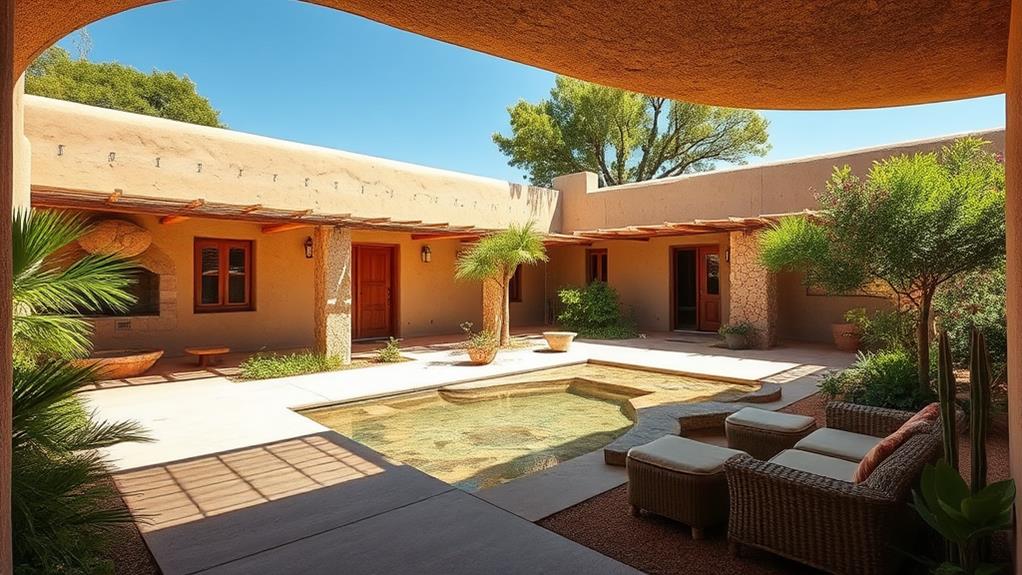
Thermal mass plays a crucial role in regulating indoor temperatures, particularly in hot climates. This principle involves using dense materials with high heat capacity to absorb and store thermal energy during the day, releasing it slowly at night when temperatures drop. Common thermal mass materials include concrete, brick, stone, and water.
In hot climates, thermal mass can be strategically incorporated into building design to reduce temperature fluctuations and minimize cooling needs. Thick walls, floors, and ceilings made of high-density materials can effectively absorb excess heat during peak daytime temperatures. This stored heat is then gradually released during cooler nighttime hours, helping to maintain a more stable indoor temperature.
To maximize the benefits of thermal mass, it should be combined with proper insulation and ventilation strategies. Night purging, which involves opening windows or using mechanical ventilation to flush out warm air and cool the thermal mass, can enhance its effectiveness. Additionally, shading thermal mass elements from direct sunlight during the hottest parts of the day can prevent overheating and improve overall cooling performance. When properly implemented, thermal mass can significantly reduce reliance on active cooling systems and lower energy consumption in hot climates.
Ventilation and Air Circulation Strategies
While thermal mass strategies focus on heat absorption and storage, effective ventilation and air circulation are key components in managing indoor comfort in hot climates. Proper airflow helps remove excess heat, humidity, and stale air from indoor spaces, creating a more comfortable environment.
Natural ventilation techniques, such as cross-ventilation and stack effect, can be employed to maximize air movement. Cross-ventilation involves strategically placing windows or openings on opposite sides of a room to allow air to flow through. Stack effect utilizes temperature differences to create vertical air movement, often achieved through high ceilings and roof vents.
Mechanical ventilation systems, including ceiling fans, whole-house fans, and attic fans, can supplement natural ventilation. These devices help circulate air and create a cooling effect through evaporation. In areas with high humidity, dehumidifiers can be integrated to remove excess moisture from the air.
Proper insulation and sealing of the building envelope are crucial for maintaining efficient ventilation. This prevents unwanted heat gain and ensures that cooled air remains inside. Additionally, incorporating features like operable windows, louvers, and wind catchers can enhance air circulation and provide occupants with greater control over their indoor environment.
Smart Shade Automation Systems
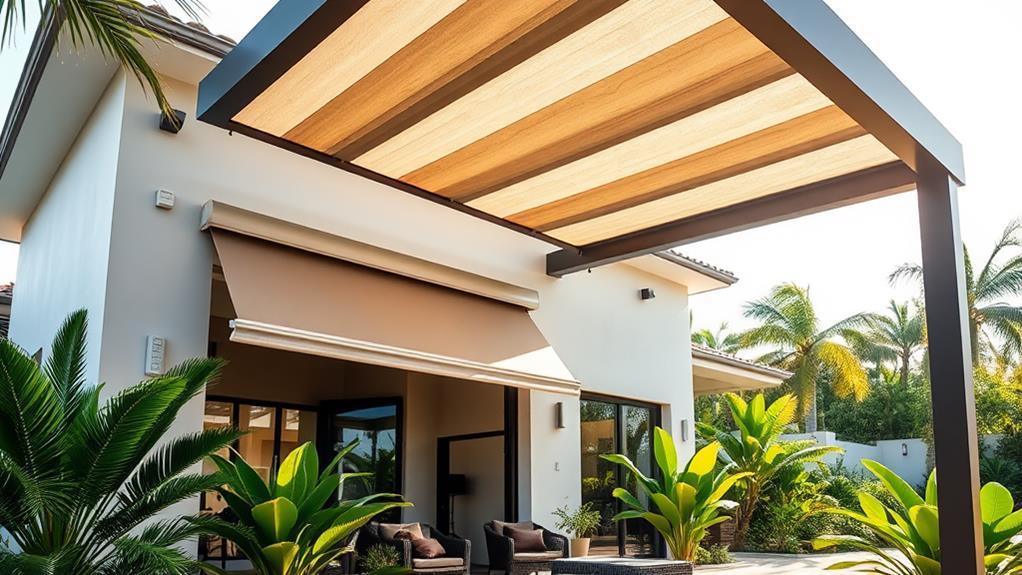
Smart shade automation systems represent a cutting-edge approach to managing solar heat gain in hot climates. These systems utilize sensors, motors, and intelligent controls to adjust shading devices automatically based on environmental conditions.
By dynamically responding to sunlight intensity, temperature, and time of day, smart shades optimize natural light while minimizing heat buildup.
Key components of these systems include motorized blinds, roller shades, or exterior louvers connected to a central control unit. Sensors detect solar radiation, indoor temperature, and occupancy patterns to inform the system's decision-making process.
Advanced algorithms analyze this data to determine optimal shade positions throughout the day, balancing energy efficiency with occupant comfort.
Smart shade automation offers several benefits in hot climates. It reduces cooling loads by blocking solar heat before it enters the building, potentially lowering energy consumption by up to 30%.
These systems also enhance occupant comfort by preventing glare and maintaining consistent indoor temperatures. Integration with building management systems allows for seamless coordination with HVAC and lighting controls, further optimizing overall energy performance.
As technology advances, smart shade automation continues to evolve, offering increasingly sophisticated solutions for sustainable cooling in challenging climates.
Frequently Asked Questions
How Much Can Renovating for Shade Reduce Energy Costs?
Renovating for shade can significantly reduce energy costs, potentially lowering cooling expenses by 15-50%. The exact savings depend on factors such as climate, building design, and shading methods implemented. Proper shade solutions offer substantial long-term financial benefits.
Are Shade-Focused Renovations Eligible for Government Incentives or Rebates?
Many governments offer incentives or rebates for energy-efficient home improvements, including shade-focused renovations. These may include tax credits, grants, or low-interest loans. Check with local authorities or energy departments for available programs in your area.
What's the Typical Return on Investment for Shade-Related Home Improvements?
Like planting a money tree, shade-related home improvements typically yield a positive return on investment. Homeowners can expect energy savings of 15-35% annually, with potential property value increases of 5-10% depending on the specific upgrades implemented.
How Do Shade Renovations Affect Property Value in Hot Climates?
Shade renovations in hot climates can significantly enhance property value. They improve energy efficiency, reduce cooling costs, and increase comfort, making homes more attractive to buyers. This can result in a higher resale value and quicker sales.
Can Shade Renovations Be Effectively Implemented in Rental Properties?
Research confirms that shade renovations can be effectively implemented in rental properties. Landlords can benefit from reduced cooling costs, increased tenant satisfaction, and potentially higher rental rates. However, considerations include installation costs and maintenance responsibilities.
Conclusion
In the quest for thermal comfort in hot climates, a multifaceted approach to renovation emerges as the optimal solution. Like a well-orchestrated symphony, each cooling strategy harmonizes with the others to create a comprehensive thermal management system. From strategic landscaping to smart shade automation, these techniques work in concert to mitigate heat gain, enhance natural cooling, and reduce energy consumption. By embracing these innovative solutions, buildings can become oases of comfort in even the most challenging climates.
